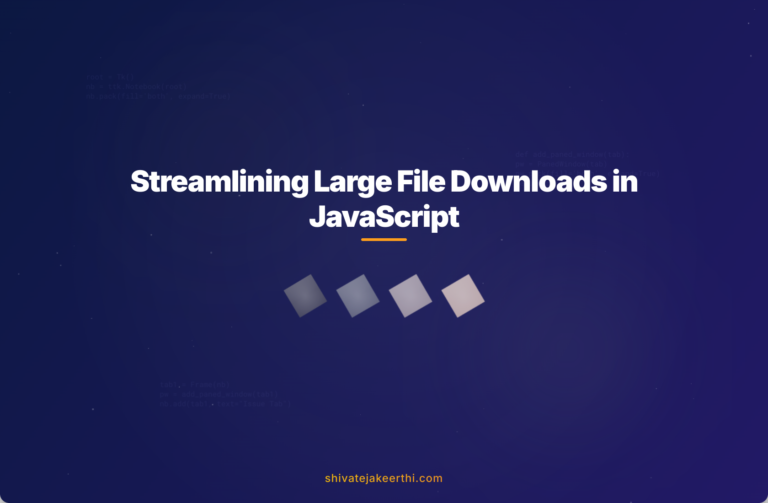Downloading files directly from a ReadableStream without first converting them into a Blob can be tricky. While the traditional method of creating a Blob object works fine for smaller files, it comes with its own set of limitations, particularly when dealing with large data sets. So, what’s the better alternative? Can we bypass Blob entirely?
To understand this better, let’s quickly refresh what exactly a ReadableStream is.
Understanding ReadableStreams in JavaScript
A ReadableStream is a built-in JavaScript object designed to handle streaming data efficiently. Imagine streaming movies online—rather than waiting for the whole file to download before playback, the content streams bit-by-bit, allowing immediate interaction. The same logic applies to JavaScript streams—they handle data incrementally and asynchronously, which is beneficial for performance and user experience.
Although streams are efficient, directly downloading their contents as files traditionally involved extra steps like using Blobs.
Using Blobs for Downloading ReadableStreams
Most developers are familiar with the traditional method of saving streamed data as files through a Blob. It typically involves storing the streamed data into memory, creating a Blob object, then generating a temporary URL using URL.createObjectURL(). The browser then initiates a download via this temporary URL.
Here’s a quick example illustrating this common approach:
async function downloadViaBlob(readableStream, filename) {
const reader = readableStream.getReader();
const chunks = [];
while (true) {
const { done, value } = await reader.read();
if (done) break;
chunks.push(value);
}
const blob = new Blob(chunks);
const url = URL.createObjectURL(blob);
const a = document.createElement('a');
a.href = url;
a.download = filename;
document.body.appendChild(a);
a.click();
URL.revokeObjectURL(url);
a.remove();
}
Although the Blob method is straightforward and highly popular among developers, it comes with a few potential problems.
Potential Drawbacks with the Blob Method
While downloading files using a Blob is reliable, there are some key downsides:
- Increased memory usage: Blobs store the entire file contents in memory at once. Large files could consume significant resources, potentially slowing down or crashing the browser tab.
- Performance bottlenecks: Applications with intensive streaming or large files might suffer performance hits, particularly on devices with lower memory capacity.
- Temporary URLs: If improperly managed, temporary URLs can leak memory since failing to call URL.revokeObjectURL leaves unused URLs lingering in memory.
Given these limitations, many developers seek an alternative approach—one that lets them skip Blobs entirely.
Challenges of Directly Downloading from ReadableStreams
Directly saving streams without Blob introduces specific complexities:
- Browsers typically expect Blobs or File objects to initiate downloads via URLs.
- Direct streaming can pose compatibility issues as not all browsers fully support stream-to-file downloads without intermediary steps.
- Managing data flow between streams and download triggers efficiently can be complex.
Luckily, there’s a neat solution you can use to download directly from streams, significantly optimizing memory usage.
Downloading Files Directly from ReadableStreams (No Blobs!)
Yes, there is a convenient and efficient solution. You can achieve it by using JavaScript’s built-in Response constructor, which conveniently accepts a ReadableStream as input. This method significantly simplifies the process and improves performance.
Here’s how you’d do it:
async function downloadFromStream(readableStream, filename) {
const response = new Response(readableStream);
const data = await response.arrayBuffer();
const url = URL.createObjectURL(new Blob([data]));
const anchor = document.createElement('a');
anchor.href = url;
anchor.download = filename;
document.body.appendChild(anchor);
anchor.click();
URL.revokeObjectURL(url);
anchor.remove();
}
Although technically, this approach still uses a Blob at the very end, it directly converts a stream to an ArrayBuffer before creating a minimal temporary Blob used only for generating a URL. The primary benefit here: dramatically reduced memory usage compared to holding all chunks in memory.
Handling Large Data Efficiently
What if you have a massive volume of data? For large downloads, you might want to stream data directly to disk without buffering everything in memory at once:
- Use chunked streaming to fetch data progressively rather than buffering.
- Utilize specialized libraries or browser APIs like the experimental File System Access API for direct stream-to-disk interactions, whenever applicable.
Here’s an example leveraging chunked downloads for reduced memory impact:
async function streamFileDownload(url, filename) {
const response = await fetch(url);
const reader = response.body.getReader();
const fileStream = streamSaver.createWriteStream(filename);
const writableStream = fileStream.getWriter();
while(true) {
const {value, done} = await reader.read();
if (done) break;
await writableStream.write(value);
}
await writableStream.close();
}
This method works great using a third-party library like StreamSaver.js, allowing the browser to handle downloaded data directly without filling up RAM.
Comparing the Approaches
Different methods suit different use-cases:
- Traditional Blob Method: Easy setup, widespread browser support, convenient for small-to-medium-size downloads.
- Direct Stream-to-Response: Beneficial memory optimization, suitable for moderate-to-large data with improved performance vs traditional.
- Chunked streaming methods (e.g., using StreamSaver.js): Excellent memory handling for substantial data streaming directly to disk.
Choose your approach based on file size, browser compatibility, and performance requirements.
Implementing & Testing Your Custom Solution
Testing your download implementation is crucial. To evaluate performance:
- Monitor memory usage with browser DevTools to identify inefficiencies or leaks.
- Test across popular browsers and devices to ensure compatibility and performance consistency.
- Consider network variations—simulate slow connections using browser developer tools to confirm reliable downloads under various conditions.
Performing these tests ensures your solution is robust and ready for production scenarios.
Downloading streams directly, or nearly directly, optimizes browser performance immensely, especially noticeable with significant data downloads. Keep future developments in mind: browsers continue to evolve, introducing experimental APIs like the File System Access API and native Streams APIs improvements, which offer promising avenues for further streamlining downloads.
Have you tried downloading large streams directly without relying on Blobs? What approaches worked well for you—or didn’t? Feel free to share your experiences or questions below!



0 Comments